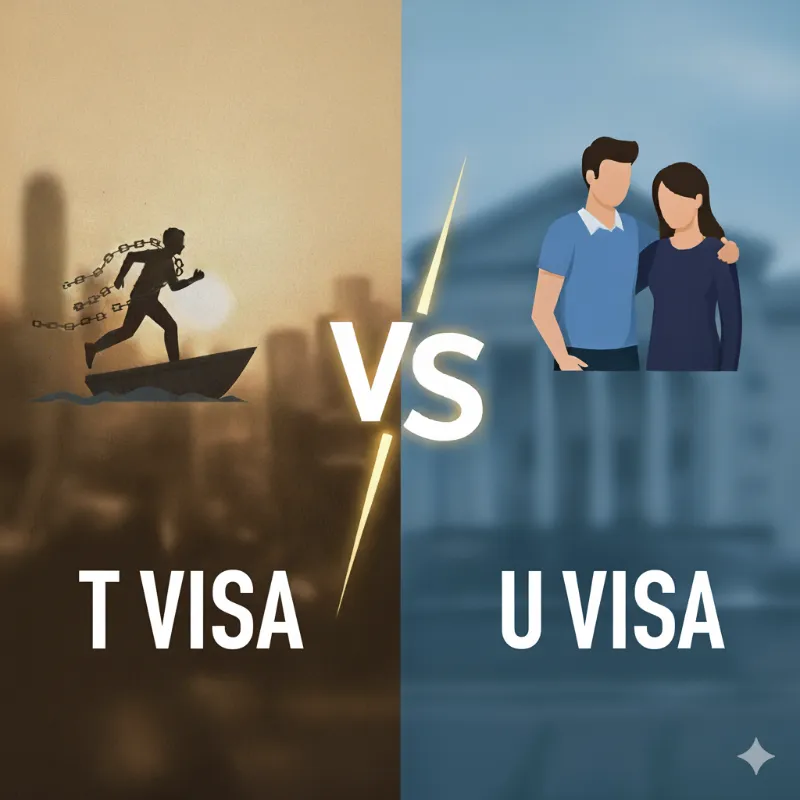Applying for a Green Card after being “waived through” the U.S. border is a complex process. The key issue is proving you were “inspected and admitted” or “inspected and paroled,” which is a foundational requirement for adjusting your status to a permanent resident while in the U.S. “Waived through” generally falls under this category, but it is not a documented entry, which can create significant challenges.
What Does “Waived Through” at the Border Mean?
“Waived through” refers to a situation where an individual presents themselves at a U.S. port of entry but is allowed to enter the country by a Customs and Border Patrol (CBP) officer without a formal inspection process, such as being questioned, having their documents thoroughly reviewed, or receiving a stamp in their passport or a formal I-94 record.
Understanding Waived Entry and Inspection by Customs Border Patrol (CBP)
The formal inspection process is what legally distinguishes a lawful entry from an unlawful one. To be considered legally “inspected and admitted,” an individual must present themselves to a CBP officer as an “alien” and be authorized to enter the U.S. A “waived through” entry can be considered a lawful entry, but only if the person presented themselves for inspection and didn’t make a false claim (e.g., claiming to be a U.S. citizen).
Common Scenarios Where Immigrants are Waived Through
This scenario often happens at land borders, particularly with individuals who have a valid visa, but the CBP officer, for a variety of reasons, decides to let them pass without fully completing the typical inspection procedure. The result is a lack of a clear paper trail or digital record of the entry.
Am I Eligible for a Green Card if I Was Waived Through?
Whether you’re eligible for a green card after being waived through hinges on a specific legal concept: “inspection and admission”.
The Importance of “Inspection and Admission” for Green Card Applications
To “adjust status” to a permanent resident from within the U.S. using Form I-485, you must prove that you were “inspected and admitted” or “inspected and paroled.” A “waived through” entry, provided you did not make a false claim to citizenship, is generally considered an “inspection and admission” for the purposes of a green card application, even though it was a cursory inspection.
When Are You Considered Legally Admitted to the U.S.?
You are considered legally admitted when you apply for admission as an “alien” at a port of entry and a CBP officer authorizes you to enter. This is true even if the inspection was brief. However, if you enter by making a false claim of U.S. citizenship, you are considered to have entered without inspection, which can lead to significant problems.
Problems with Proving Legal Entry
The primary difficulty with a “waived through” entry is the lack of documentation. You won’t have a Form I-94 or an entry stamp in your passport, which are the standard proofs of lawful entry. This creates a burden of proof on you to demonstrate to U.S. Citizenship and Immigration Services (USCIS) that you were, in fact, inspected and admitted.
How Does Being Waived Through Affect Adjustment of Status (Form I-485)?
Adjustment of Status Requirements
The I-485 application requires you to show that you are eligible for a green card and that you meet the requirements to adjust your status from within the U.S. A key part of this is proving your lawful entry.
The Role of Form I-94 and Other Entry Records
A Form I-94 is a crucial document that serves as proof of your legal admission and the authorized length of your stay. Since most “waived through” individuals don’t have one, you’ll need to use other methods to prove your entry.
Proving Lawful Entry After Waived Through
Without an I-94 or a passport stamp, you will need to submit other compelling evidence to USCIS. This can include:
- Affidavits from people who were with you at the time of entry (e.g., family or friends).
- Corroborating documentation, such as travel records, vehicle toll receipts, or other evidence showing you were at or near a port of entry on a specific date.
- Third-party records that place you in the U.S. shortly after the claimed entry date.
What If I Entered the U.S. Without Inspection or Documentation?
Difference Between Waived Through and Entry Without Inspection (EWI)
The distinction between “waived through” and “entry without inspection” (EWI) is critical. EWI means you entered the United States without formal admission by an immigration officer at an official border crossing. Waived through is a form of inspection that satisfies the inspected and admitted requirement for applying for a green card in the U.S.
Legal Risks of Adjustment of Status After Undocumented Entry
If you entered the U.S. without inspection, you generally cannot adjust your status from within the country. Your only option would be to leave the U.S. and apply for an immigrant visa at a U.S. consulate abroad. This process can trigger a 3- or 10-year bar on re-entry, which is why a waiver of inadmissibility would be necessary.
Grounds of Inadmissibility and Waivers
Possible Inadmissibility Issues (Unlawful Presence, Prior Violations)
If you overstayed your welcome after a “waived through” entry, you may have accrued “unlawful presence.” This can make you inadmissible to the U.S. and trigger a 3- or 10-year bar on re-entry if you leave the country. Other grounds of inadmissibility can include certain criminal convictions, fraud, or misrepresentation.
Provisional Unlawful Presence Waiver (Form I-601A): Who Qualifies?
The I-601A provisional waiver is designed to help individuals who are inadmissible only because of unlawful presence. To qualify, you must have an approved I-130 petition (or similar), be 17 years or older, be physically present in the U.S., and be able to demonstrate that your U.S. citizen or permanent resident spouse or parent would experience “extreme hardship” if you were not allowed to return. Children cannot serve as qualifying relatives for this waiver.
How to File for a Waiver of Inadmissibility
The process for filing a waiver of inadmissibility is complex. The specific form and process depend on the reason for your inadmissibility. For unlawful presence, you would file Form I-601A. The application requires extensive documentation to prove the “extreme hardship” to your qualifying relative.
Special Family Situations: Marriage to a U.S. Citizen or Green Card Holder
Immediate Relative Green Card Process for Those Waived Through
If you are an “immediate relative” of a U.S. citizen (spouse, unmarried child under 21, or parent), you may have a more favorable path. Immediate relatives are often exempt from some of the bars to adjustment of status, such as having worked without authorization. However, you still need to prove your lawful entry, which is the main challenge with a “waived through” entry.
Extreme Hardship Requirement Explained
“Extreme hardship” is a high legal standard. It’s more than just the normal emotional and financial difficulties of a family living apart. You must provide extensive evidence, such as medical records, financial hardship, psychological evaluations, and political or social conditions in your home country, to prove that your qualifying relative would suffer exceptionally.
Steps to Take Before Applying for a Green Card if You Were Waived Through
Consulting an Immigration Attorney
Given the complexities, this is the most critical step. An experienced immigration attorney can help you determine if your “waived through” entry can be successfully argued as a lawful admission and guide you through the process of gathering and presenting the necessary evidence. For a comprehensive and honest case evaluation, we recommend consulting with a firm like AKN Immigration based in Gilbert, Arizona, which specializes in adjustment of status and waiver solutions.
Gathering Evidence of Entry or Waiver
Begin collecting all possible evidence to support your claim of a lawful entry. This includes sworn affidavits from family members or friends, dated photos near the border, receipts, and any other records from that time period.
Preparing for Possible Green Card Interview or Request for Evidence
Be prepared for a possible interview with a USCIS officer. The officer will likely ask for specific details about your entry. You should also be ready to respond to a Request for Evidence (RFE) from USCIS, which is a common occurrence in these types of cases.
Common Reasons for Green Card Denial After Waived Through (and How to Respond)
Incomplete Evidence of Entry
The most frequent reason for denial is a failure to provide sufficient evidence that you were, in fact, “inspected and admitted.” The response is to gather and submit more robust documentation.
Failure to Demonstrate Eligibility
A denial can also happen if you fail to meet other eligibility criteria for your green card category (e.g., proving a bona fide marriage).
How to Appeal or Reapply After a Denial
If your application is denied, you may have the option to file Form I-290B to appeal the decision. In some cases, a reapplication may be a better option, but it is crucial to consult with an attorney to understand the best course of action.
Resources and Where to Get Help
Reputable Immigration Attorneys and Services
For expert assistance, it is essential to consult with a qualified immigration attorney or a reputable legal aid organization. Avoid working with “notarios” or non-lawyer consultants, as they may provide inaccurate advice.
A firm like AKN Immigration offers personalized legal guidance and support. You can also find a qualified attorney through the American Immigration Lawyers Association (AILA).
USCIS Information and Latest Policy Changes
Stay informed by checking the official USCIS website for the latest information on policies, forms, and procedures. Immigration law is subject to change, and what was true a few years ago may not be true today.
Frequently Asked Questions
Yes, it is possible, but you must prove that you were “inspected and admitted,” even without a standard entry document. This requires submitting compelling evidence.
Since you likely don’t have a passport stamp or I-94, you’ll need to gather alternative evidence, such as affidavits from witnesses, travel records, and any other documentation that supports your claim of being at the border on a specific date.
The absence of these documents is the central challenge. You must provide other evidence to meet the burden of proof for your “inspected and admitted” entry.
“Waived through” implies you presented yourself to an immigration officer, which is a form of inspection. “Crossing illegally” means you avoided inspection entirely. The legal difference is critical, as only a waived-through entry is considered a lawful entry for adjustment of status purposes.
A waiver of inadmissibility is a legal request to forgive a past immigration violation. The process involves filing a specific form with USCIS, such as Form I-601A for unlawful presence, and providing extensive evidence to demonstrate “extreme hardship” to a qualifying U.S. relative.
Yes, the fact that you were a child at the time of entry does not automatically disqualify you, but you still need to prove the “inspected and admitted” entry.
If your application is denied, you may have the option to file a motion to reconsider or reopen the case, or you can appeal the decision to the Board of Immigration Appeals (BIA). This would require the guidance of an immigration attorney.






